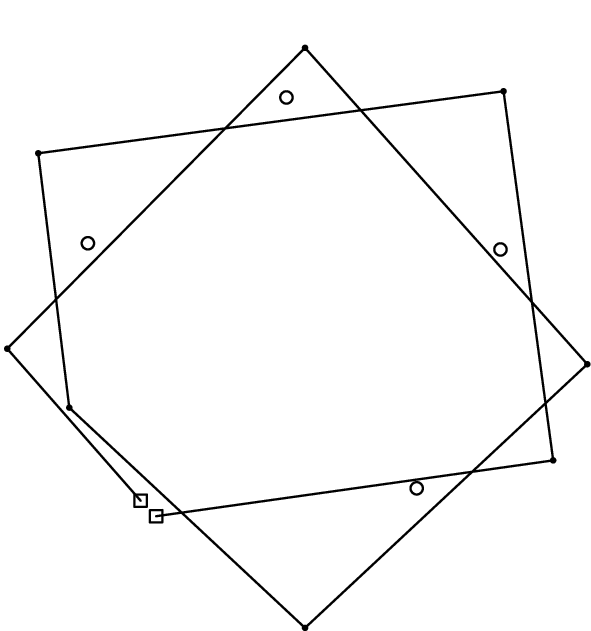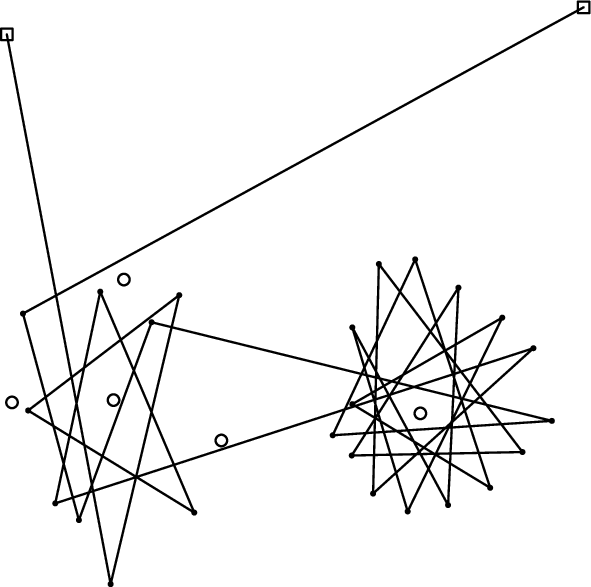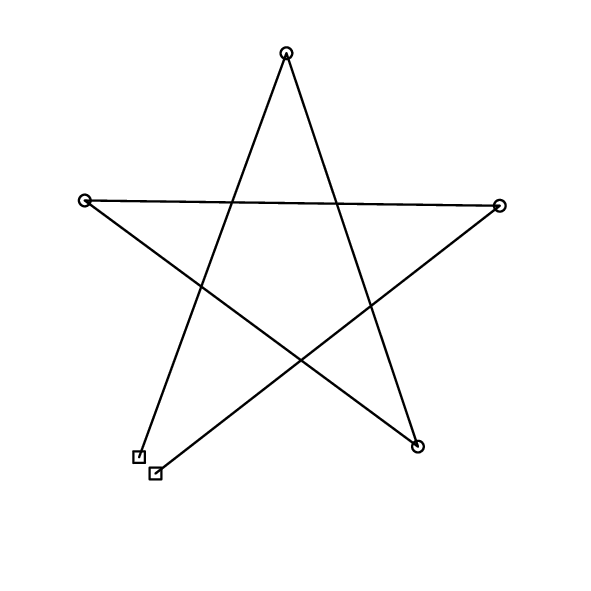Problem F: Tighten Up!
We have a flat panel with two holes. Pins are nailed on its surface. From the back of the panel, a string comes out through one of the holes to the surface. The string is then laid on the surface in a form of a polygonal chain, and goes out to the panel's back through the other hole. Initially, the string does not touch any pins.
Figures F-1, F-2, and F-3 show three example layouts of holes, pins and strings. In each layout, white squares and circles denote holes and pins, respectively. A polygonal chain of solid segments denotes the string.

Figure F-1: An example layout of holes, pins and a string

Figure F-2: An example layout of holes, pins and a string

Figure F-3: An example layout of holes, pins and a string
When we tie a pair of equal weight stones to the both ends of the string, the stones slowly straighten the string until there is no loose part. The string eventually forms a different polygonal chain as it is obstructed by some of the pins. (There are also cases when the string is obstructed by no pins, though.)
The string does not hook itself while being straightened. A fully tightened string thus draws a polygonal chain on the surface of the panel, whose vertices are the positions of some pins with the end vertices at the two holes. The layouts in Figures F-1, F-2, and F-3 result in the respective polygonal chains in Figures F-4, F-5, and F-6. Write a program that calculates the length of the tightened polygonal chain.

Figure F-4: Tightened polygonal chains from the example in Figure F-1.

Figure F-5: Tightened polygonal chains from the example in Figure F-2.

Figure F-6: Tightened polygonal chains from the example in Figure F-3.
Note that the strings, pins and holes are thin enough so that you can ignore their diameters.
Input
The input consists of multiple datasets, followed by a line containing two zeros separated by a space. Each dataset gives the initial shape of the string (i.e., the positions of holes and vertices) and the positions of pins in the following format.
m n
x1 y1
...
xl yl
The first line has two integers m and n (2 ≤ m ≤ 100, 0 ≤ n ≤ 100), representing the number of vertices including two holes that give the initial string shape (m) and the number of pins (n). Each of the following l = m + n lines has two integers xi and yi (0 ≤ xi ≤ 1000, 0 ≤ yi ≤ 1000), representing a position Pi = (xi ,yi ) on the surface of the panel.
- Positions P1, ..., Pm give the initial shape of the string; i.e., the two holes are at P1 and Pm , and the string's shape is a polygonal chain whose vertices are Pi (i = 1, ..., m), in this order.
- Positions Pm+1, ..., Pm+n are the positions of the pins.
Note that no two points are at the same position. No three points are exactly on a straight line.
Output
For each dataset, the length of the part of the tightened string that remains on the surface of the panel should be output in a line. No extra characters should appear in the output.
No lengths in the output should have an error greater than 0.001.
Sample Input
6 16 5 4 11 988 474 975 459 16 985 12 984 982 242 227 140 266 45 410 92 570 237 644 370 567 406 424 336 290 756 220 634 251 511 404 575 554 726 643 868 571 907 403 845 283 10 4 261 196 943 289 859 925 56 822 112 383 514 0 1000 457 514 1000 0 485 233 224 710 242 850 654 485 915 140 663 26 5 0 953 180 0 299 501 37 301 325 124 162 507 84 140 913 409 635 157 645 555 894 229 598 223 783 514 765 137 599 445 695 126 859 462 599 312 838 167 708 563 565 258 945 283 251 454 125 111 28 469 1000 1000 185 319 717 296 9 315 372 249 203 528 15 15 200 247 859 597 340 134 967 247 421 623 1000 427 751 1000 102 737 448 0 978 510 556 907 0 582 627 201 697 963 616 608 345 819 810 809 437 706 702 695 448 474 605 474 329 355 691 350 816 231 313 216 864 360 772 278 756 747 529 639 513 525 0 0
Output for the Sample Input
2257.0518296609 3609.92159564177 2195.83727086364 3619.77160684813